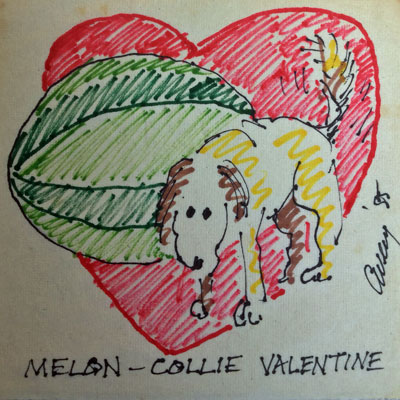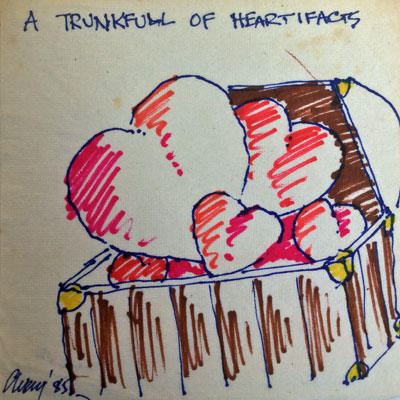[Click on BLUE links for sources and information]
On the night of the festival of Lupercalia, in the second year of the reign of Claudius Gothicus, in the 1022nd year since the founding of the city, at the order of Quintus Mimmius, procurator of games, Valentine was lashed to a post outside the Flaminian Gate of the city and shot dead with arrows. Chet Raymo, Valentine: A Love Story

Sea Gull Cellar Bar Napkin Art, BB artist
From Feb. 13 to 15, the Romans celebrated the feast of Lupercalia. The men sacrificed a goat and a dog, then whipped women with the hides of the animals they had just slain … The Roman romantics “were drunk. They were naked,” says Noel Lenski, a historian at the University of Colorado at Boulder. Young women would actually line up for the men to hit them, Lenski says. They believed this would make them fertile … The brutal fete included a matchmaking lottery, in which young men drew the names of women from a jar. The couple would then be, um, coupled up for the duration of the festival — or longer, if the match was right … Later, Pope Gelasius I muddled things in the 5th century by combining St. Valentine’s Day with Lupercalia to expel the pagan rituals. But the festival was more of a theatrical interpretation of what it had once been. Lenski adds, “It was a little more of a drunken revel, but the Christians put clothes back on it. That didn’t stop it from being a day of fertility and love.” Arnie Siepel, The Dark Origins of Valentine’s Day
Valentine’s Day is one of the “religious” holidays I most enjoyed growing up. With a pounding heart I picked the most beautiful Valentine card to give to the whichever girl I lusted over at the time hoping, of course, that I would get a special card from her. Usually all I got was whichever one came out of the box. Nothing special. No sweet notes. It was emotionally devastating, but I survived.

Sea Gull Cellar Bar Napkin Art, Bob Avery artist
Today, according to the Greeting Card Association, an estimated 145 million Valentine’s Day cards are sent each year, making Valentine’s Day the second largest card-sending holiday of the year (more cards are sent at Christmas). Women purchase approximately 85 percent of all valentines. Borgna Brunner, History of Valentine’s Day
I didn’t know it at the time but Saint Valentine had a precarious position in Church lore. I was raised by a Catholic mother while my father was a Mason– a recipe for schizophrenia. They divorced when I was about a year old. As was customary, I lived with my mother and my father visited from time to time. I was raised a Catholic. Somewhere between JV football and the Senior Prom I realized that religion made little sense to me. I adored William Blake and found his Marriage of Heaven and Hell more inspiring than the Stations of the Cross although I enjoyed the Roman (and other) histories weaved into the Bible. For all of these reasons and because of my admiration for Chet Raymo’s blog, Science Musings, I was a willing sucker for his book Valentine: A Love Story. It’s a great read for Valentine’s Day. I highly recommend it.

Sea Gull Cellar Bar Napkin Art, Max Efroym artist
In 1969, the Catholic Church revised its liturgical calendar, removing the feast days of saints whose historical origins were questionable. St. Valentine was one of the casualties. Borgna Brunner, History of Valentine’s Day
Chet Raymo’s Valentine is a complicated character. As a young man searching for his destiny, he did what talented young men do and asked the questions such men ask.
His first two years in the employ of Theophrastus consisted, he told me frankly, of three parts: work, study and fornication … Why must we discount this world, with its exquisite beauties and pleasures, and go chasing after an illusion of paradise—a disembodied existence that is impossible even to imagine except in terms of this body?
I keep a list of skeptics (nonbelievers, rationalists, materialists, secularists, doubters, atheists, name them as you wish) who espouse a sort of soft atheism, not completely antithetical to religion. Chet Raymo is one of these. He calls himself a “religious naturalist.”

Sea Gull Cellar Bar Napkin Art, Bob Avery artist
As one reviewer of Raymo’s book puts it:
This is a cautionary tale for our own intolerant, violent times. But what can we do against the tide of history, personal and monumental? Live decently, honestly, lovingly, intelligently. As Julius Marius Favus the jailor says, “Valentine died for love, yes…for my darling Julia. And for philosophy. Like Lucretius, he had sought to undeceive his own thought, to scrape through the encrustation of myth…”
A few quotes from Raymo’s book demonstrate the truth of these comments.
Anyone with a smattering of literature will remember Juvenal’s tirade, Now that no one buys our votes, the public has lost its care for democracy; the people that once bestowed commands, consulships, legions and all else now meddles no more with politics and long eagerly for just two things—bread and circuses.
Rome, it sometimes seems ,is cess pit to the empire. Even the emperor stays away, avoiding the stench and putrefaction.Yet somehow Romans continue to believe that they are exemplars of culture and refinement, when in fact their sole export to the world is a harrowing cruelty and unprincipled hedonism.
This is one reason Raymo’s story resonates with me especially in these times. It’s a good Valentine’s Day read. I finished it in just one day and enjoyed it immensely. Some attribute Geoffrey Chaucer with connecting Valentine’s Day with love. In “Parliament of Fowls” he wrote: “For this was on Saint Valentine’s Day, when every bird comes there to choose his mate.” Others cite Shakespeare’s Ofelia who spoke of herself as Hamlet’s Valentine. As for me, I prefer Raymo’s mythical Valentine whose love for a jailer’s blind daughter changed his life.

Sea Gull Cellar Bar Napkin Art, Jane Gardener artist
Julia made me see that his teaching was of tolerance and charity, not unlike the ideals of my old friend and teacher Theophrastus. However, I cannot accept that your Galilean carpenter was divine or that he rose from the dead or performed miracles. All of this leads back into the quagmire which is Rome, with its deification of the emperor and proliferating gods. But when Jesus says—or rather when Julia says—Enter by the narrow gate, since the road to perdition is wide and spacious, I hear something that I once knew to be true but had forgotten.
Raymo’s book is a wonderful Valentine’s Day gift. Simple but full of witty observations, inspired myth based on an incomplete history, full of love, intrigue, and interesting details on third century Rome. Happy Valentine’s Day!

Sea Gull Cellar Bar Napkin Art, Estelle Grunewald artist


One of your best postings to date . . .